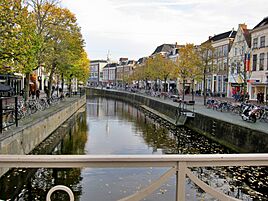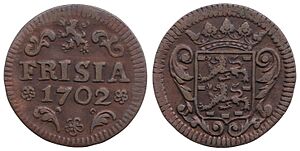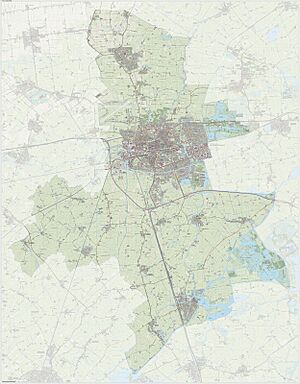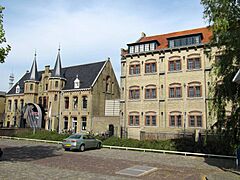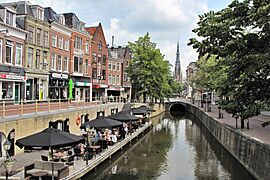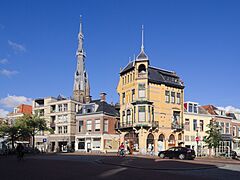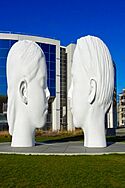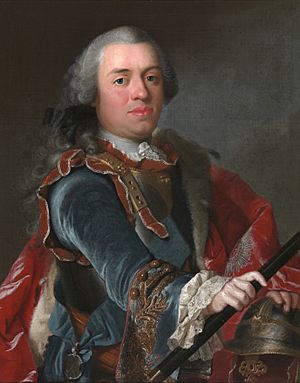Leeuwarden facts for kids
Quick facts for kids
Leeuwarden
Ljouwert (West Frisian)
Liwwadden / Leewarden (Town Frisian) |
|||||
|---|---|---|---|---|---|
|
City and municipality
|
|||||
|
Leeuwarden canal
Former weigh house
Leeuwarden centre
Oldehove
Fries Museum
|
|||||
|
|||||
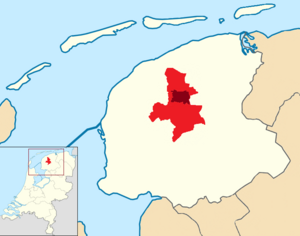
Location of the municipality (red) and the city (dark red) in the province of Friesland in the Netherlands
|
|||||
| Country | |||||
| Province | |||||
| Government | |||||
| • Body | Municipal council | ||||
| Area | |||||
| • Municipality | 166.99 km2 (64.48 sq mi) | ||||
| • Land | 151.70 km2 (58.57 sq mi) | ||||
| • Water | 15.29 km2 (5.90 sq mi) | ||||
| Elevation | 3.2 m (10.5 ft) | ||||
| Highest elevation | 5.2 m (17.1 ft) | ||||
| Lowest elevation | 1.9 m (6.2 ft) | ||||
| Population
(Municipality, May 2014; Urban and Metro, May 2014)
|
|||||
| • Municipality | 108,249 | ||||
| • Density | 714/km2 (1,850/sq mi) | ||||
| • Urban | 108,254 | ||||
| • Metro | 174,724 | ||||
| Demonym(s) | Leeuwarder | ||||
| Time zone | UTC+1 (CET) | ||||
| • Summer (DST) | UTC+2 (CEST) | ||||
| Postcode |
8900–8941
|
||||
| Area code | 058 | ||||
Leeuwarden is a city and municipality in Friesland, Netherlands. It is the capital city of the Friesland province. In 2023, about 127,073 people lived there.
People have lived in this area since the 10th century. The name Leeuwarden was first used in the early 9th century. The city received special city rights in 1435. Today, Leeuwarden is an important place for business in Friesland. It is known for its green spaces and many waterways.
Leeuwarden has a historic city center with many old buildings. It also has a large shopping area with squares and restaurants. In 2018, Leeuwarden was named the European Capital of Culture. Since 2019, it has also been a UNESCO City of Literature.
The famous Elfstedentocht (Eleven Cities Tour) starts and finishes in Leeuwarden. This is a long ice skating tour that visits eleven cities in Friesland.
The municipality of Leeuwarden includes several towns and villages. Some of the larger ones are Stiens, Grou, and Goutum. The city is led by Mayor Sybrand van Haersma Buma.
Contents
Understanding the Name "Leeuwarden"
The name "Leeuwarden" has a long history. Historians have found over 200 different ways the name has been spelled! Today, the most common spellings are Leeuwarden (Dutch), Liwwadden (Town Frisian), and Ljouwert (West Frisian).
The second part of the name, Warden, is easier to understand. It means an artificial hill where people lived. These hills are called terps. This shows how people used to live on raised land to avoid floods.
The first part, leeuw, means "lion" in modern Dutch. This is why the city's coat of arms has a lion on it. However, some experts think the name might have come from older words. It could be from luw- (meaning 'sheltered from the wind') or lee- (meaning 'waterway'). So, "Leeuwarden" might have originally meant a 'sheltered landing place or harbor'. This makes sense because the city was once connected to an important waterway called the Middelzee.
Leeuwarden's Past
The first signs of houses in Leeuwarden date back to the 2nd century AD. This was during the Roman era. People have lived here continuously since the 10th century. The city was first mentioned in German writings in 1285. It officially became a city in 1435.
Leeuwarden was once a busy trading port. It was located along the Middelzee, a waterway that connected it to the sea. However, this waterway filled up with mud in the 13th century.
The Grote of Jacobijnerkerk (Great, or Jacobin Church) is the oldest building in the city. It was built in the 15th century. During this time, the city also built walls and a moat for protection. From 1580 to 1752, Leeuwarden had its own mint. It made gold, silver, and copper coins for Friesland.
The Jewish community in Leeuwarden was one of the first in the Netherlands. They were first mentioned in 1645. By 1670, they had permission to build a cemetery. The first synagogue was built in the 17th century. The Jewish community grew throughout the 18th and 19th centuries.
In 1901, the city's population was 32,203 people.
World War II and Beyond

During World War II, Leeuwarden was occupied by German forces from 1940 to 1945. The city was freed by the Royal Canadian Dragoons on April 15, 1945. The city and the Dragoons still celebrate this day every year.
An important event happened on November 16, 1951, called Kneppelfreed (Baton Friday). This was a protest about using the Frisian language in courts. Police used force against the activists. This event led to the Frisian language getting legal status as a minority language.
In 2013, a large fire broke out in a shopping street. It destroyed several shops and flats. Sadly, one person died. The birthplace of the famous spy Mata Hari was nearby. It was damaged but survived the fire.
City Symbols
The coat of arms of Leeuwarden is the city's official symbol. It features a golden lion on a blue shield, topped with a crown. The lion might be linked to the "Leeuw" part of the city's name, which means "lion." However, some believe the lion was added later. It might also have been a gift from a powerful local family.
Leeuwarden's Location and Surroundings
Leeuwarden is located in the middle of Friesland. The Leeuwarden Air Base is to the northwest of the city. To the east, you can find De Groene Ster. This is a recreational area and nature reserve. It has a windmill called Himriksmole, a golf course, and AquaZoo Friesland, a zoo with water animals.
The municipality of Leeuwarden has grown over the years. Parts of nearby municipalities were added in 2014 and 2018. As of 2020, the total population of the municipality was 124,084. Most people living in Leeuwarden are Dutch natives.
Culture and Fun in Leeuwarden
Museums to Explore
Leeuwarden has many interesting museums:
- Fries Museum: This museum tells the story of Friesland's art, culture, and history. It includes the Fries Verzetsmuseum, which shows how World War II affected Friesland.
- Princessehof Ceramics Museum: Here you can see beautiful ceramics.
- Pier Pander Museum: This museum is dedicated to the works of sculptor Pier Pander.
- Natuurmuseum Fryslân: A natural history museum where you can learn about nature.
- The Other Museum: This museum has collections of old cars, model trains, lace, and photography.
- Tresoar: A historical center with archives about Friesland.
- Fries Landbouwmuseum: An agricultural museum about farming.
Amazing Buildings
Leeuwarden has over 800 Rijksmonuments, which are national heritage sites. The Oldehove is a famous leaning, unfinished church tower. It is a symbol of the city. Other well-known buildings include the Kanselarij (a former government building) and the Stadhouderlijk Hof (a former royal residence). The city hall, built in 1715, and the Waag (old weigh house) are also important. The Saint Boniface church is a beautiful example of neogothic style. The Centraal Apotheek is a pharmacy built in the Art Nouveau style.
The Blokhuispoort is a former prison. It has been changed into a public library, a hostel, and a restaurant. The Froskepôlemolen is the last windmill left in Leeuwarden. The Slauerhoffbrug is a unique bridge. It is also called the 'Flying' Drawbridge because it uses two arms to swing a section of road out of the way.
The tallest building in the city is the Achmeatoren, which is 114 meters (374 feet) tall. It was built in 2001.
Fun Events and Festivals
In 2018, Leeuwarden was the European Capital of Culture. Many events were held that year. One big art project was the 11Fountains. These are fountains placed in the eleven cities of Friesland. The Love Fountain is in front of the train station. It was designed by artist Jaume Plensa. It is seven meters tall and shows two white heads of a boy and a girl.
Leeuwarden hosts many annual music festivals. These include Cityrock, Dancetour, and Into the Grave. Other festivals are the Noordelijk Film Festival for filmmakers and the Noorderlicht photo festival. A large flower market is held every year on Ascension Day. There is also a weekly cattle market.
Getting Around Leeuwarden
Leeuwarden railway station is the city's main train station. It opened in 1863. You can take trains from here to Zwolle, Groningen, and Harlingen. There are also other train stations in the municipality, like Leeuwarden Camminghaburen.
Next to the train station is the bus station. Buses connect Leeuwarden to many places. For example, you can take a bus to Holwerd to catch the ferry to Ameland. Another bus goes to Lauwersoog for the ferry to Schiermonnikoog.
Major roads like the A31 and A32 pass through or connect to Leeuwarden. The Van Harinxmakanaal is an important canal. It links Harlingen to Leeuwarden.
Learning in Leeuwarden
Leeuwarden has several respected schools of applied science. These are called HBO schools in Dutch. In 2017, there were 21,480 students. Examples include the Van Hall Instituut for agricultural sciences and the NHL Stenden University of Applied Sciences. The city also has three regional vocational schools.
While Leeuwarden doesn't have its own university, some universities have campuses here. These include Campus Fryslân from the University of Groningen. Dairy Campus is part of Wageningen University and Research.
Technological Top Institute Wetsus does research on water technology. The Centre of Expertise Water Technology (CEW) focuses on water technology research and product development.
Leeuwarden's Economy
Leeuwarden has many important employers. Some of the largest include the Medical Center Leeuwarden (MCL) and ING. Other big employers are the Central Judicial Collection Agency (CJIB) and Achmea. The NHL Stenden University of Applied Sciences and Leeuwarden Air Base also employ many people. FrieslandCampina, a large dairy company, is another major employer.
WTC Expo is the biggest events complex in the Northern Netherlands. It hosts many different shows and events.
Sports in Leeuwarden
Leeuwarden has its own football team, SC Cambuur. They play in the Eerste Divisie, which is the second-highest football league in the Netherlands. Their home stadium is the Cambuur Stadion. The city's basketball team, Aris Leeuwarden, has been in the Dutch Basketball League since 2004.
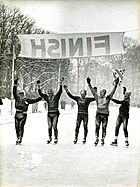
The Elfstedenhal is a sports venue. It is used for ice skating, ice hockey, and curling. The 400-meter indoor speed skating track is named after the famous speed skater Atje Keulen-Deelstra. The local ice hockey team is IJshockeyclub Capitals Leeuwarden.
Leeuwarden is famous as the start and finish point for the Elfstedentocht. This is a 200-kilometer (120-mile) speed skating race. It takes place on the Frisian waterways when the winter weather is cold enough. The last time it happened was in January 1997. Before that, it took place in 1986 and 1985. In 1986, the Dutch king Willem-Alexander even participated using a secret name!
Loop Leeuwarden is an annual running competition. It includes 5 km, 10 km, and half marathon races. It started in 1985 and happens every May. Leeuwarden also has two sailing boats that race in the yearly Skûtsjesilen competition.
Leeuwarden was supposed to host the World Ultimate and Guts Championships in 2020. This is a big event for flying disc sports. However, it was canceled due to the COVID-19 pandemic.
Local Media
The main daily newspapers in Leeuwarden are the Leeuwarder Courant and Friesch Dagblad. They are mostly written in Dutch. Omrop Fryslân is a public broadcaster. It offers radio and TV programs mainly in the Frisian language.
Famous People from Leeuwarden
Many notable people were born or lived in Leeuwarden. Here are a few:
- Lawrence Alma-Tadema (1836–1912): A famous painter.
- M. C. Escher (1898–1972): A well-known graphic artist.
- Mata Hari (1876–1917): A famous dancer and spy.
- Jan Jacob Slauerhoff (1898–1936): A poet and novelist.
- Saskia van Uylenburg (1612–1642): The wife of the famous painter Rembrandt van Rijn.
- William IV, Prince of Orange (1711–1751): A former leader of the Netherlands.
- Joost Klein (born 1997): A rapper and singer who participated in the Eurovision Song Contest 2024.
Sister Cities
Leeuwarden has a sister city relationship with:
 Liyang, China (since 2011)
Liyang, China (since 2011)
See also
 In Spanish: Leeuwarden para niños
In Spanish: Leeuwarden para niños


